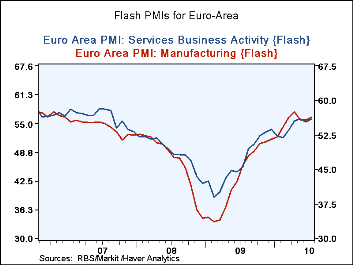 Global| Jul 22 2010
Global| Jul 22 2010EMU Flash PMIs Resume Their Rise
Summary
The FLASH PMIs for EMU from Markit show that the European expansion's death has been greatly exaggerated. In July the MFG PMI advanced to a reading of 56.48 from 56.64 in June. The Services PMI rose to 55.98 in July from 55.51, also [...]
 The FLASH PMIs for EMU from Markit show that the European expansion's death has been greatly exaggerated.
The FLASH PMIs for EMU from Markit show that the European expansion's death has been greatly exaggerated.
In July the MFG PMI advanced to a reading of 56.48 from 56.64 in June. The Services PMI rose to 55.98 in July from 55.51, also in June. After dropping for two months running the rise in the MFG PMI was a surprise. The Services PMI is back on the growth track after just a one month drop.
While it is hard to conclude that the PMIS are still on a rising gradient, since these are diffusion indices any reading above 50 indicates a rise in overall activity in the sector. A rise in the index reading once it gets above a level of 50, suggests not just growth but acceleration. This month's readings say that the economy has accelerated in both key sectors after a one or two month period of somewhat lower growth.
In terms of the absolute strength, the rankings of the two indices in their respective ranges show the MFG sector stands in the 85th percentile and the services sector stand lower in the its 72nd percentile. Both are quite respectable firm readings, perhaps short of being called strong. The rankings obtained by looking at the relative standing of each index in its historic queue shows the MFG sector at about the same place, (slightly lower) in its 83rd percentile, but the services reading drops to its 66th percentile just short of being a top-third reading.
In relative terms the MFG sector is doing much better. Services, although at about the same raw reading as MFG, has a higher average reading and that is reflected in its queue standing being lower even at the same raw value.
However, for this business cycle where economists were looking for backsliding, the rise in the two indices suggests that killing off European growth may be harder than they thought. The rise in these two readings suggests that the European economy has more resilience and that the timely actions by the EU and the ECB may have been enough to breathe new life into a Zone where risk threatened to short cut a blossoming expansion. The news, while short of stellar, is better than expected and overall not bad at all.
By themselves the Markit PMIs are encouraging but not decisive.
| FLASH Readings | ||
|---|---|---|
| Markit PMIs for the Euro-Area | ||
| MFG | Services | |
| Jul-10 | 56.48 | 55.98 |
| Jun-10 | 55.64 | 55.51 |
| May-10 | 55.84 | 56.17 |
| Apr-10 | 57.57 | 55.60 |
| Segment Averages | ||
| 3-Mo | 56.35 | 55.80 |
| 6-Mo | 55.39 | 54.76 |
| 12-Mo | 52.47 | 53.35 |
| 144-Mo Range | ||
| High | 60.47 | 62.36 |
| Low | 33.55 | 39.24 |
| % Range | 85.2% | 72.4% |
| Range: | 26.92 | 23.12 |
| AVERAGE | 51.30 | 53.73 |
| Rank Stand | 83.9% | 65.7% |
Robert Brusca
AuthorMore in Author Profile »Robert A. Brusca is Chief Economist of Fact and Opinion Economics, a consulting firm he founded in Manhattan. He has been an economist on Wall Street for over 25 years. He has visited central banking and large institutional clients in over 30 countries in his career as an economist. Mr. Brusca was a Divisional Research Chief at the Federal Reserve Bank of NY (Chief of the International Financial markets Division), a Fed Watcher at Irving Trust and Chief Economist at Nikko Securities International. He is widely quoted and appears in various media. Mr. Brusca holds an MA and Ph.D. in economics from Michigan State University and a BA in Economics from the University of Michigan. His research pursues his strong interests in non aligned policy economics as well as international economics. FAO Economics’ research targets investors to assist them in making better investment decisions in stocks, bonds and in a variety of international assets. The company does not manage money and has no conflicts in giving economic advice.






